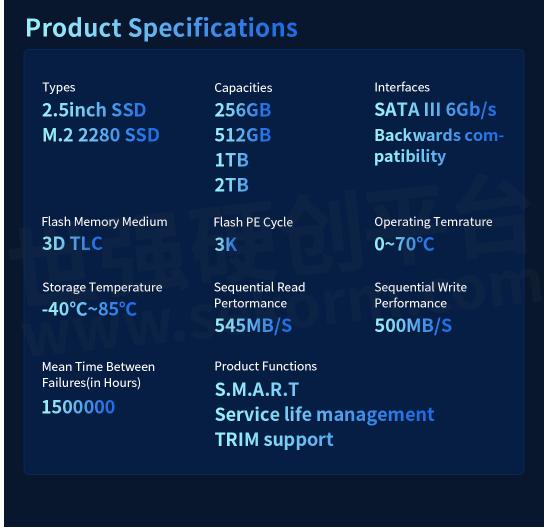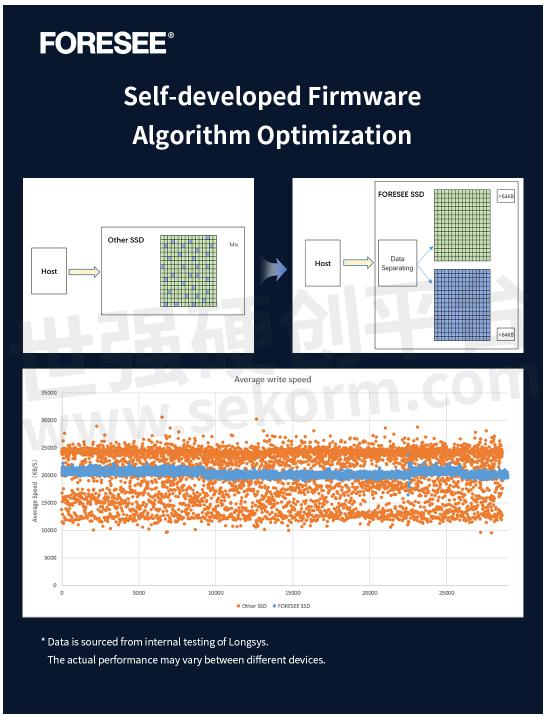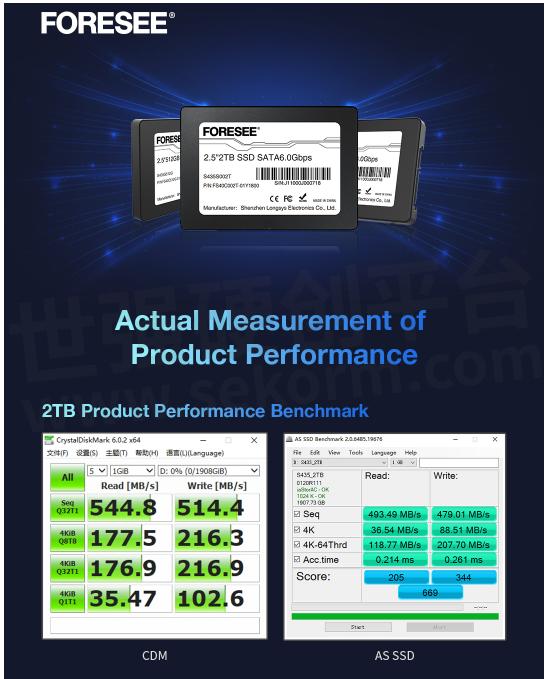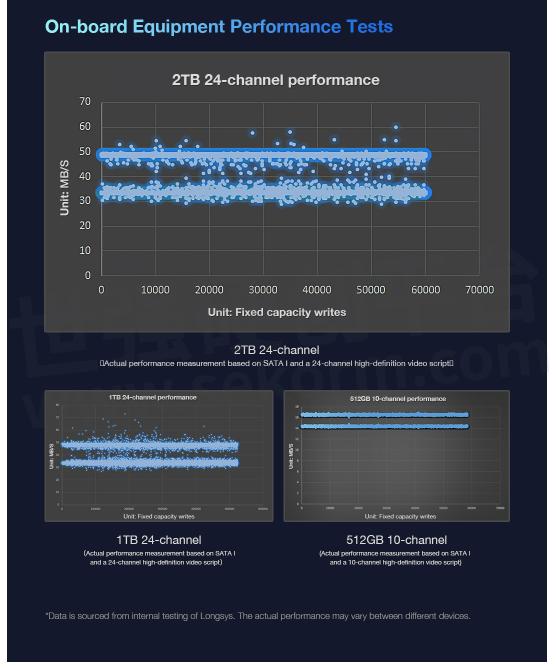The First FORESEE Large-capacity SSD for Vehicle-mounted Monitoring Systems Supports 24-channel High-definition Recording

With the continuous development of storage technology, many vehicle-mounted monitoring applications have switched from traditional HDDs (hard disk drives) to faster, more stable and shockproof SSDs (solid state drives).
FORESEE, an industrial storage brand under Longsys (301308.SZ) recently launched its first SATA SSD product that is specially designed for multi-channel vehicle-mounted monitoring systems. The SSD is already being widely used in vehicle-mounted devices.
Available in both 2.5inch and M.2 2280, the SSD product boasts 3D TLC NAND flash chips with 3,000 P/E cycles, is DRAM-less, and features proprietary Longsys firmware. With capacity options of 512GB, 1TB, and 2TB, it supports 24-channel 1080p high-definition video recording equipment, providing vehicle-mounted monitoring system customers with more market-competitive storage choices.



Generally, PC users will not be affected by regular garbage collection (GC) behaviors of SSDs when there is abundant free disk space. However, compared with traditional PC application scenarios, vehicle-mounted multi-channel video recording scenarios are a bit special. In such scenarios, logical block addresses (LBAs) are not written, covered, and reused in sequence, data blocks in partitions are in different sizes, and the disk space usage rate is 100%. But with the continuous writing of video data, LBAs become very random and GC behaviors are triggered frequently, resulting in slow terminal performance that fluctuates and frame drops.
In addition, strong vibration, high and low temperature fluctuations, humidity changes, and other harsh environmental factors in such scenarios bring many challenges to vehicle-mounted monitoring systems.
FW algorithm optimizations
No frame drops in writing
FORESEE SSDs for vehicle-mounted monitoring systems are specially made for vehicle-mounted application scenarios. In particular, the following algorithmic optimizations have been made.
1. Bad block management:
Because SSDs are prone to bad blocks, especially in vehicle-mounted video recording scenarios where a large amount of data needs to be written and read continuously, it is necessary to adopt special bad-block management algorithms, such as bad block replacement and wear leveling, to prolong the service life of SSDs and ensure their stability and reliability.
2. Data caching:
The read and write speeds of SSDs are relatively fast, so a data caching algorithm can be adopted to improve the efficiency of reading and writing data. In vehicle-mounted video recording, data caching technology can be used to cache a certain amount of data to ensure the smoothness of video recording and playback.
3. Data distribution:
Data is distributed by identifying its sequence and randomness to reduce data fragmentation and implement efficient garbage collection.
4. TRIM function:
SSDs require regular use of the TRIM function to clear useless data, which improves read and write efficiency and prolongs their service life. In vehicle-mounted video recording, the stability and reliability of SSDs can be ensured by regularly using the TRIM function.
5. Efficient garbage collection:
Block reservation: Some blocks in SSDs are reserved for garbage collection. When a block is fully written, it can be directly marked as a garbage block, which does not require garbage collection. This can prevent frequently using garbage collection and improve the write performance. Fine-grained garbage collection: Splitting SSDs into smaller blocks can make garbage collection more fine-grained. This can prevent garbage collection in a whole block and improve garbage collection efficiency.

By adopting various optimization algorithms such as bad-block management, data caching, data distribution, TRIM, and efficient garbage collection, FORESEE vehicle-mounted monitoring SSDs ensure that no frames drop during intense multi-channel data writing. These functions can improve the application efficiency and reliability of SSDs in vehicle video recording, and prolong the service life of SSDs in vehicle-mounted equipment by reducing data fragmentation and GC wear. They also support S.M.A.R.T firmware online upgrades, temperature control technology, LDPC, and other proprietary functions, providing terminal equipment with strong error correction capabilities in their life cycles, ensuring continuous stable operations in hot, cold, humid, and other climates and environments, and greatly improving the reliability and security of video data.
SATA III interface support
Compatible with mainstream on-board equipment in the market
Vehicle-mounted monitoring systems support SATA I and SATA II interfaces. Designed in accordance with SATA III specifications, the interface of FORESEE SSDs features both backward compatibility and upward compatibility, preparing the SSDs for the future interface iterations of monitoring systems. FORESEE has joined hands with several on-board equipment providers to complete compatibility tests at the verification stage and gained extensive practical experience to ensure that the SSDs can adapt to mainstream vehicle-mounted monitoring systems in the market and meet the requirements for smooth speeds during simultaneous multi-channel writing.


- +1 Like
- Add to Favorites
Recommend
- Longsys and Western Digital Expand Business Cooperation to Serve the Mobile Phone Storage Market in Greater China
- Longsys‘s Industrial Storage Brand FORESEE Helps Shape the Future of Drones
- FORESEE 1.8 V SLC Parallel NAND Flash, in Line with Industrial-Grade Temperature Requirements, Accelerated Longsys’ Expansion into the 5G Market
- FORESEE, the Industry Storage Brand of Longsys, Debuted at Embedded World 2022
- Read Speed Increased Six-fold! Longsys‘s FORESEE Automotive UFS Powers Automotive Storage Upgrades
- FORESEE LPCAMM2 Helps AI to Land, Leading a New Trend of High-Performance Memory
- FORESEE FBGA-78 Packaged DDR3L, Holding Fast to High Industry Standards and Improving Data Transmission Efficiency with Lower Power Consumption
- Duvonn and Longsys Jointly Develop a Vehicle Data Black Box
This document is provided by Sekorm Platform for VIP exclusive service. The copyright is owned by Sekorm. Without authorization, any medias, websites or individual are not allowed to reprint. When authorizing the reprint, the link of www.sekorm.com must be indicated.






























































































































































































































































































































































































































































































































































































































































































































































































































































































